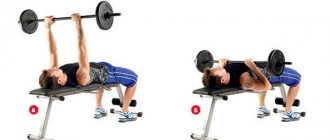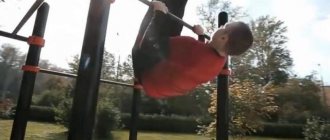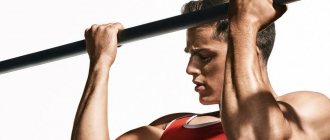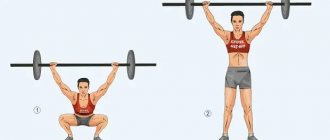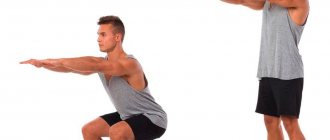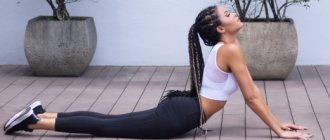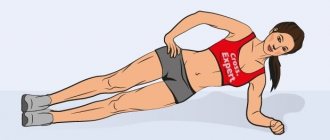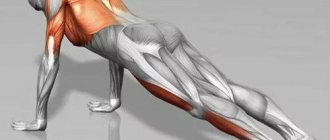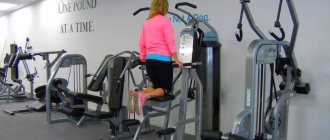Pull-ups are one of the most popular exercises. It is used in various strength sports: bodybuilding, street lifting, gymnastics, street workout, etc. This exercise helps to build good muscle volume in the upper body, as well as generally improve the functionality and endurance of your body. There are many variations of pull-ups, and each one works your muscles differently. One of the most effective variations of this movement is parallel grip pull-ups. What muscles work during this exercise? How is it different from classic pull-ups? How should it be done? You can find answers to all these questions in the article.
Pull-ups: anatomy of exercise
What muscles are pumped during parallel grip pull-ups? To get a complete answer to this question, you need to understand what types of grips exist and what the difference is between them.
All pull-up options can be divided into 3 types:
- Straight grip pull-ups (classic). With this positioning of the arms, the latissimus muscles receive the main load, while the indirect load is distributed to the biceps.
- Reverse grip pull-ups. Here the biceps do the main work; the latissimus muscles are indirectly involved in the work.
- Parallel grip pull-ups. What muscles work here? In this position, the load between the biceps and lats is distributed almost evenly.
Muscle work
Pull-ups with a neutral grip on the horizontal bar help shift the load to the lower region of the latissimus muscles. The hands also work. Thus, the exercise loads the following main groups:
- latissimus dorsi muscle (emphasis on the lower sections);
- biceps (biceps brachii muscle);
- brachial muscle (brachialis).
Yes, girls do this too.
The deltoids, serratus and teres major muscles additionally receive a certain load. As a result, we can conclude that the exercise is used primarily to work out the lower region of the latissimus and is most often used as an auxiliary exercise.
Features of pull-ups with parallel arms
What muscles work when doing parallel grip pull-ups? We think this is all clear. Now let's take a closer look at the features of performing this movement.
To perform pull-ups with parallel arms, there must be appropriate handles on the bar. Such a horizontal bar cannot always be found on the street, but, as a rule, it is found in every modern fitness center. If you have hanging bars, you can use them as a crossbar with parallel handles (just hang them higher).
The main advantage of parallel pull-ups is that the bar does not interfere with you while performing this exercise, making this movement more convenient and functional.
How to gain weight using a horizontal bar
For good muscle growth and weight gain when exercising on the horizontal bar, a well-known rule applies - a calorie deficit. You need to consume more than you burn during training. It is also worth including more protein and carbohydrate foods in your diet. At the same time, the consumption of baked goods and sugar should be reduced. When training, you need to drink more water, as it normalizes metabolic processes in the body.
To gain weight, you need to follow a daily routine. It is advisable to go to bed before 23.00, and it is better to devote 8-10 hours to sleep. Exercising every day is acceptable if the program involves pumping up various muscle groups
groups. In any case, for beginners it is better to exercise 3-4 times a week. At the same time, for better weight gain, short (up to an hour) but highly effective workouts should be performed. It is better to eat up to 5 times a day in small portions. The dosage interval should be 2-3 hours.
Execution technique
The technique of performing pull-ups with parallel arms is not very different from the technique of classic pull-ups:
- Grasp the bar with a close to medium parallel grip.
- As you exhale, lift your torso up until your chin is above the level of the bar. Try to work only with your hands; your body should not participate in the exercise. At the top point, take a short pause (1-2 seconds) to properly feel the muscles.
- Inhaling, slowly lower yourself to the starting position.
- Complete the number of repetitions you need.
The technique of performing pull-ups with a medium parallel grip is clearly shown in the following video.
Medium overhand grip
This is a classic option. This type of pull-up is performed both in physical education classes and by American special forces. The main emphasis is on the biceps and back muscles.
To perform this stretch, you must do the following:
- grab the horizontal bar with your hands spaced shoulder-width apart;
- hang and bend your back a little;
- cross your legs so that your body does not become loose;
- pull yourself up, bringing your shoulder blades together.
When the body is at the extreme point, you need to touch the crossbar with your upper chest. Muscles are best stretched when the arms are fully extended. Otherwise, it will not be possible to achieve full stretching.
Pull-ups with a medium parallel grip: what is special and what muscles work
Pull-ups with a wide parallel grip are not very comfortable from a biomechanical point of view, so a variation of the exercise with a medium or narrow hand position is more effective and safe.
The creator of the Nautilus simulators, Arthur Jones, was an ardent fan of this particular method of pull-ups. Here the handles are located at a distance of 55-60 centimeters. With this option, the palms face each other and the arms are in a semi-reverse position, but a neutral position is also acceptable.
Wide grip to chest
Different types of pull-ups have different effects on our muscles. This option is the most useful. But, as is usually the case, the best comes only through hard work. This is the most difficult version of pull-ups, which causes panic among beginners. Moreover, even among gym regulars there is not always a person who knows how to do wide-grip pull-ups correctly. In this case, several dorsal muscles come into play at once: paired teres, trapezius and latissimus.
You need to grab the bar from above, with a grip approximately equal in width to the grip for a bench press. An important nuance is that the thumb should clasp the horizontal bar from above, like all other fingers. This small trick allows you to better stretch your back muscles. Without straining your biceps, rising by bringing your shoulder blades together, you need to pull yourself up until the top of your chest touches the bar. When this position is already close, you need to bend your back and look up. Ideally, you should stay at the top point for a few seconds.
Pull-ups with a narrow parallel grip: what muscles work, what is the peculiarity of the exercise
For this variation, you need to use a special handle from a horizontal or vertical block. Just remove it from there and, if possible, hang it on the horizontal bar. If there is no handle, you can simply grab the bar, but then you will have one hand a little further from the body than the other (as shown in the picture below). This means that the load will be distributed slightly differently. It is necessary to pull yourself up with this position of your hands on each side of the horizontal bar in turn. That is, the total number of pull-ups must be even.
With both a medium and narrow grip, the load between the biceps and latissimus muscles is distributed approximately 50/50, as we said earlier.
The essence of the exercise and its benefits
Why is it not enough to only do pull-ups with a wide grip? Bodybuilding sources believe that the wider the grip, the more the latissimus and teres muscles work. Pumping them up helps to acquire that very “inverted triangle” look that gym visitors strive for. And if you do pull-ups with a narrow grip, part of the load is taken by the biceps and rhomboid muscles of the back. This allows you to pump up the so-called depth, that is, make the muscles thicker.
It turns out that both options are needed for aesthetics. Those who value health should know that a close grip in a pull-up allows you to balance the shoulder abductors and pectoral muscles. An athlete who pulls up with both a medium and close grip can easily keep his shoulders turned and not slouch.
The close-grip pull-up is the “key to athletic arms” that many are looking for when performing a million concentrated biceps curls in one workout.
The benefits of close grip pull-ups
The key to arm and back strength is performing the exercise with a large range of motion. So, pull-ups with a medium and narrow grip are a back exercise with the largest working amplitude. It allows you not only to develop “muscle thickness”, but also to significantly increase strength indicators. The movement is suitable for those who have problems with the standing press and pushes, as well as problems with regular pull-ups. Increasing your results in pull-ups with a medium and narrow grip will allow you to do more biceps lifts too.
This is one of the exercises that should be included in training if a person is actively pumping the chest or bench pressing for strength results. Close-grip pull-ups help compensate for muscle work
This is important for the prevention of injuries to the elbow and shoulder joints and good posture.
Contraindications
It is believed that pull-ups are ideal for postural disorders, scoliosis, kyphosis and hyperlordosis. But that's not true. Many people, in addition to hernia curvatures, also have various compensatory changes in the shoulder joints. If one shoulder is lower than the other, there are postural problems and similar problems, you should definitely consult a doctor so as not to aggravate your condition.
Those who have protrusions and hernias should not be pulled up during an exacerbation. Also, the doctor must decide which technique is optimal for the patient to work with, since kipping and butterfly, as well as minimal assistance with the legs, create a load on the spine.
You will have to give up pull-ups for a while if you cannot heal injuries to ligaments and joints, as well as inflammatory processes in the muscles. Beginners should not use plans like "100 pull-ups" to avoid overtraining and causing harm to themselves.
A contraindication is also the exacerbation of diseases associated with loss of orientation in space - epilepsy, disorders of the central nervous system. You should pull yourself up carefully if the weight is heavy and your grip does not hold. In this case, straps are used.
Close grip pull-ups. Correct technique for performing the exercise. Training video
Watch this video on YouTube
Parallel grip pull-ups in gravitron
Parallel pull-ups can also be done in a gravitron. Despite the fact that this variation of the exercise is less effective, it has the following advantages:
- The ability to perform correct (from a technical point of view) pull-ups even with a low level of physical fitness.
- Beginners who still find it difficult to do pull-ups with their own weight can hone the exercise technique on it.
- Since the body is in a fixed position, it is much easier for the athlete to maintain correct form. During pull-ups, the trainee will not be able to move his legs forward, throw his head back, or try to “cheat”, helping himself with jerks and sudden movements, as often happens with a free hang.
Problems of horizontal bar lovers
Pull-ups are a rather traumatic thing, especially if you haven’t done anything before. Beginners should choose rubber-coated platforms, or horizontal bars that are dug directly into the sandbox, so as not to be injured if they fall. And it is quite real, especially if there are problems with the grip and exorbitant ambitions that do not allow a person to stop training in time.
In addition, the practitioner should always have magnesium on hand to prevent slipping, calluses and damage to the skin.
Best articles: Niner. What is it and is it worth taking?
Injuries
The main way to prevent injury is to normalize your relationship with your own ego. Stop trying to force jump jumps if you don't know how to do a pull-up yet. Do not perform exercises using the force of inertia if you do not yet have enough muscle strength. Try to do everything technically and complete tasks gradually.
Well, here are the classic recommendations - first warm up by lightly running around the site, then by rotating in all the main joints, after that by pulling the rubber to your chest with the shock absorber secured on top.
Calluses
The reason for their occurrence is not excessive work, or even sweaty palms. Usually, calluses plague those who really like to hang on their fingers, and even swing at the same time. From the very first training, learn to make a palm grip so that the body does not sway from side to side and does not perform pendulum movements. This will help get rid of callus problems. If your training volume is high and you are using weights, feel free to use straps. A good grip is great, but regular training without pain and calluses is even better.
In general, some “roughness” of the palms is the norm, and it only helps to stay on the horizontal bar.
Ligament pain
Here it is necessary to distinguish between inflammation of the ligaments and joints, which are dangerous to health, and muscle soreness. Soreness is a normal practice, and it cannot harm your training in any way. On the contrary, you should actively warm up on days that are not heavy training.
But if the ligaments and joints hurt at night, become inflamed, or seem to “tug” when you are at rest, it is better to consult a doctor to rule out health problems.
Falls from the horizontal bar
This is also normal practice; you need to learn to jump softly and onto the surface. But in fact, most often those who do not use magnesium and who have a weak grip fall from horizontal bars. The second category of athletes must simply develop their grip. If the metal of the crossbar is smooth and slippery, it is worth wrapping a medical plaster around the crossbar to ensure normal adhesion to the coating.
Tips and tricks
Below are some helpful tips that will help you improve your pull-up performance and make your workouts more effective and safe:
- Don't do pull-ups every day. If you train hard every day to failure, it will negatively affect your athletic performance. With frequent physical activity, your body simply will not have time to recover, which is why you will quickly drive it into a state of overtraining. If you're using parallel pull-ups to tone your biceps and back muscles, perform this exercise only on the day you train those muscles (that is, once or twice a week).
- Always warm up. Parallel pull-ups are a fairly safe exercise, but this is not a reason not to warm up before performing them. During a warm-up, you warm up your muscles, joints and tendons and prepare them for heavier workloads, which significantly reduces the risk of injury.
- Do everything technically. This advice applies not only to the exercise discussed today, but to absolutely all activities. Due to incorrect technique, firstly, you reduce the effectiveness of the movement performed several times, and secondly, you increase the likelihood of injury. Before you add an exercise to your training system, make sure that you have studied the technique of doing it in detail.
Pull-up program
Thanks to the scheme, designed for thirty-week classes, the practitioner will be able to not only optimally “multiply” the number of pull-ups performed and determine his daily norm, but also get a beautiful, toned and athletic body. After just 15 weeks, you will be able to complete 52 sit-ups, and after 30 weeks, the number of pull-ups will increase to 82.
Don't forget: daily training is mostly suitable only for professionals, but even they need at least one day off a week. Beginners train to the best of their abilities, because in the initial stages, muscles can grow even during rest. In addition, novice athletes are recommended not to perform five approaches at a time, but to stretch the training during the day into three or four approaches.
If your goal is not just to pump up muscles, but to increase the effectiveness of pull-ups, then this program is ideal for you!
82 PULL-UPS! Myth or Reality? /// Pull-up program THAT WORKS!
Educational videos on the topic
What muscles work when doing parallel grip pull-ups? We have already said everything that could be said on this topic. Now we would like to share with you a useful video that explains in detail the technique of parallel pull-ups, as well as how they differ from other variations of this exercise.
So, what is the difference between grips in pull-ups, which muscles are included in the work when doing pull-ups with a parallel grip? We think we have managed to give a complete answer to these questions. We hope that our article was useful and you learned a lot of interesting and educational facts.
Neutral grip along the bar
It is a rather specific type of pull-up on a horizontal bar. This pull-up is aimed at working the latissimus inferior serratus muscles and to some extent the shoulder muscles. The bar is grasped so that one palm is in front of the other. While doing pull-ups, bend your back and try to touch the bar with your chest (lower part). The head is turned away from the projectile, changing sides with each pull-up. Hands change with a new approach. To make the exercise more comfortable, a V-shaped handle is often hung on the horizontal bar.
Grips when training with a barbell.
When performing exercises with a barbell, a closed grip is often used, which allows you to clearly fix the projectile in your hands. But there are still athletes who find it more convenient to hold the barbell with an open grip. This mainly applies to barbell exercises on the back and presses, especially the bench press, but since it is not safe, it will be better to use a closed grip.
The choice of a forward or reverse grip is often determined by the exercise itself, but different grip widths are often used when exercising with a barbell. All kinds of presses and rows are often recommended to be performed with different grip widths, which contributes to a more complete development of the target muscles.
Why are different grips used?
Different grips are used to pump muscles from different angles, more concentratedly affecting one or another area of the muscle group. By changing your grip, you change the groups of muscles being worked.
Thus, it turns out that there is no universal answer to the question: Which grip will be correct or which grip will be more effective. In most cases, the choice of grip will depend on the specific exercise and the goals you set for yourself when performing it.
When the exercise is performed
It is advisable to perform pull-ups with a neutral grip during back training or when training all muscle groups. It is more suitable for modification, therefore it must be performed after basic exercises. For example, a common option in powerlifting:
- Deadlift.
- Wide grip pull-ups.
- Neutral grip pull-ups.
- Barbell row to the waist.
- Hyperextension.
Exercises can be replaced with others; a similar order of exercises is also suitable for bodybuilding.
Other movements may follow, but beginners should not do too many exercises. The training program may also vary depending on the sport. After training, rock climbers can improve lagging muscles with pull-ups; lovers of parachuting also do not disdain pull-ups, since controlling the equipment, especially in the wind, requires a strong back and shoulders.
We've covered the preparation for the exercise, now it's time to decide where to perform the pull-ups.
In the gym
A sports club usually has the necessary equipment. These are horizontal bars with handles for different types of grip, a pull-up machine with a counterweight. The equipment is securely fixed and safe to use.
It is much more convenient to progress in pull-ups in the gym, since the variability is much greater. In addition, there is more equipment for warming up and it is easier to find belayers. If you have the opportunity to go to the gym, then it is better to do just that.
At home
If it is not possible to visit a sports club, then you need to install a horizontal bar in the room. Now you can purchase a large number of options for horizontal bars, in particular, combined ones, for different types of grip.
When purchasing, you should pay attention to the strength, size and type of fastening. Placing and performing the movement will require space, which may not be enough.
If a counterweight is required, you can use elastic bands or elastic bands, since not everyone has enough space to place the simulator and it is very expensive.
If there is no space to fully accommodate a combined horizontal bar, it is better to exercise in the gym or on street areas, if weather conditions permit.
